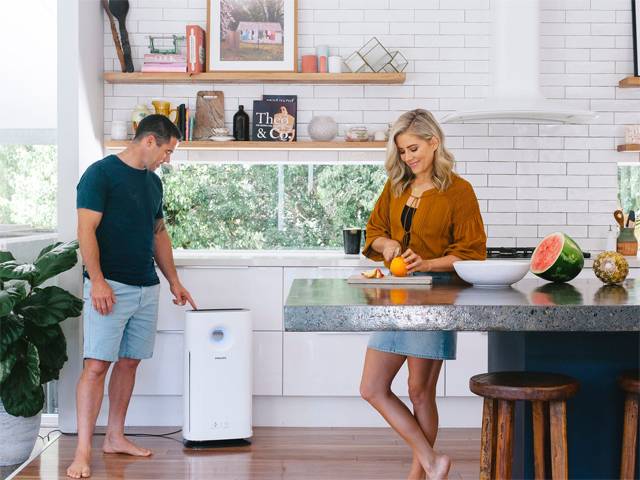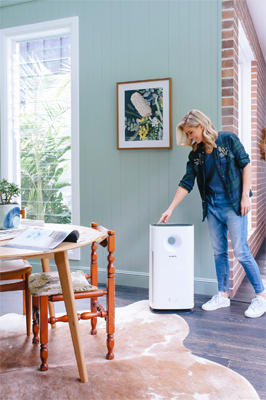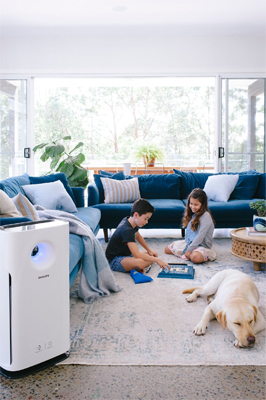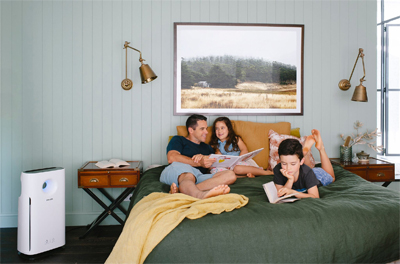Michael and Carlene Duffy Indoor Pollution Interview

Indoor Air in Australian Homes Is Often up To Five Times More Polluted than Outdoor Air
Australians are obsessed with home renovations, but in the pursuit of a perfect home, are we forgetting about the health of our home? Indoor air in Australian homes is often up to five times more polluted than outdoor air. Coupled with the fact Australians spend on average 90% of their time indoors, it shows that home improvements, more than ever, need to account for improving the air we breathe indoors. New research by Philips Air has revealed how unaware Aussies are about air pollution in their own homes and how their habits at home are impacting their indoor air quality.
Renovators, parents and local Queenslanders, Michael and Carlene Duffy from The Block, would like to share their top tips for improving air quality in your home when renovating. They are also urging people to be aware of potential indoor pollutants such as pollen, household dust, pet dander and dust mites, as well as ways to rid them from the family home. Often, these particles are so small in size they are not visible to the human eye, but that doesn't mean they don't exist.
The research polling more than 1,000 Australians reveals that while 42% are concerned about the quality of air they breathe, only a small fraction (5%) consider it the most important aspect of their home. Location (37%), build (15%) and interior design and decoration (13%) prevailing as more important than air quality amongst Australians with more than half of home owners (56%) identifying they do not consider air quality when making home upgrades.
As poor indoor air quality is a possible trigger for up to 2.5million asthma sufferers, organisations such as the National Asthma Council Australia Sensitive Choice® are supporting household appliances such as the Philips Air Purifier which monitors and indicates the air quality at home via a colour index.
 Interview with Michael and Carlene Duffy
Interview with Michael and Carlene Duffy
Question: Are you surprised that indoor air in Australian homes is often up to five times more polluted than outdoor air?
Michael and Carlene Duffy: We were completely surprised by that fact. You often associate polluted air with the outdoors but the worst culprits for poor indoor air quality are the everyday allergens like pollen, household dust, pet dander and dust mites.
Then there are the gases and odours from everyday activities like cooking and cleaning which are also contributors to the already diminishing air quality. You can't see them but they're there.
Question: What indoor pollution problems have you experienced in your own home?
Michael and Carlene Duffy: We use a Philips Air Purifier which gives real time air quality feedback through an allergen index and colour ring that lights up even with the slightest changes in air quality. We are renovating our living room and constructing a brick wall and fireplace and the colour ring has been fluctuating between purple and red throughout the build, indicating poor air quality. Ideally, you want the colour ring to remain blue which indicates good indoor air quality.
Question: What indoor pollution problems did you experience on The Block?
Michael and Carlene Duffy: Oh where do I start?! It's a very busy building site so there are pollutants galore; plaster dust, sawdust and paint fumes that not just Blockheads but all builders and renovators need to contend with.
Question: How did you fix these indoor pollution problems?
Michael and Carlene Duffy: We've created our top six tips help and these can range from better ventilation to more plants in your house. We've found Philips Air Purifiers to be super effective and easy to use.
 Question: How do you stay on top of household dust?
Question: How do you stay on top of household dust?
Michael and Carlene Duffy: Staying on top of the cleaning is a really good start to managing household dust but there are other measures you can take to help minimise the dust such as, avoiding carpet throughout. Cross ventilation within a home also helps reduce household dust. Our Philips Air Purifier is a good way to help control this and can be operating all day whether you're at home or not. It covers 95m2 so it's good peace of mind when you get slack on the vacuuming.
Question: Can you share your top tips for improving indoor air quality especially when renovating?
Michael and Carlene Duffy: 1) Air Purifiers
The triggers that can impact indoor air quality can be a hard to observe because you can't see them! Philips Air Purifiers give real time air-quality feedback through a numerical allergen index and colour ring which lights up in real time even with the slightest changes in air quality. It's eye opening! The air purifier removes 99.97% of airborne allergens like pollen, pet dander and dust mites which means you're ultimately breathing cleaner air.
2) Keep it natural
Some paints and flooring contain gases that continue to emit after installation, which can irritate allergies and contribute to poor air quality. It's for this reason that when sourcing carpet, flooring and paint, it's smart to choose low or no Volatile Organic Compounds (VOC). Product developers are becoming increasingly more conscious about offering this. Low level VOC products can cost a little more but are a worthy investment. Paint tins indicate VOC levels on the label but consult your supplier or distributor if you're unsure.
3) Houseplants
Add houseplants to your home. Not only do they look great and add life to the home, they also help filter airborne pollutants. Some plants are more effective at this than others. Bamboo palm, snake plant and peace lily are all really effective at absorbing carbon dioxide and pollutants from the air and releasing oxygen.
4) Kitchen fans
Gas stoves can really affect indoor air quality so installing a powerful extractor fan in the kitchen is essential in helping combat this and the added bonus is that the offering of rangehoods are becoming increasingly more aesthetically attractive.
 5) Trickle vents
5) Trickle vents
Airflow is crucial for good indoor air quality. Trickle ventilators are the best option for getting outside air into your home through a filter, which will increase the airflow and help remove stagnant air. High risk areas such as the kitchen are good places to house these. The vents can be easily retrofitted and installed to most buildings and even become part of an existing window or door frame to blend seamlessly into current fittings.
6) Fresh furniture
Be aware that a lot of furniture is made with solvents that continue to release toxins into the air the home, long after they have left the factory floor. It's always worth asking about the production methods used to try and overcome this where possible. Chipboard is a good example of a product high in toxins so avoid it where you can.
Question: Why is it important that we take control of our indoor pollution problems?
Michael and Carlene Duffy: When you're out and about its difficult to manage the quality of the air you breathe which is why if you can have some control over it at home, indoors then why wouldn't you? We all want to give our kids the best chance at good health and there are so many different triggers and aggravators in and around the home that can issues like asthma or allergic reactions. Dust mites, pollen, pets, smoke, VOC's (volatile organic compounds) and mould are all triggers. Dust mites and pollen are in fact, the two biggest asthma and allergy triggers in Australia.
Review:
Phillips Air Purifier looks really smart and does what it says on the box.
If you suffer from allergies, asthma or are just interested in cleaner air, this purifier will do the job. Cleaning 99.9% of bacteria per hour, the Phillips Air Purifier has 5 speed fans, plus an automatic and Allergy Mode. Quiet on the lower settings, my preference is Allergy Mode.
A built in timer allows you to preset your preferred filter times, plus the unit is light enough to be portable to other rooms.
The light colour reflects the quality of the air in the surrounding area from Blue (clean) to Red. While the PM figure indicates how dirty the air is increasing automatically when it detects pollutants in the air like smoke. It's really handy in and near the kitchen, as it will get rid of food odours that kitchen fans can't absorb.
For those that suffer from dust, animal and other airborn allergy aggrevators, the Phillips Air Purifier cleans the air efficiently capturing pollutants and provides more breathable air.
As a dust allergy suffer, I found it especially useful when spring cleaning, as I was able to continue all day when previous my limit was 40 mins even with antihistamine.
A great addition to offices heat and cool all year round to clean their stale, dusty air.
Perfect for homes with allergy and asthma suffers, or smokers.
The front casing can be easily removed if you want check the filters, first one is the basic filter, then a filter with carbon granules, with more filter layers to follow.
Phillips Air Purifier is a great addition to the home, office or workshed, very happy with my new addition.
MORE





